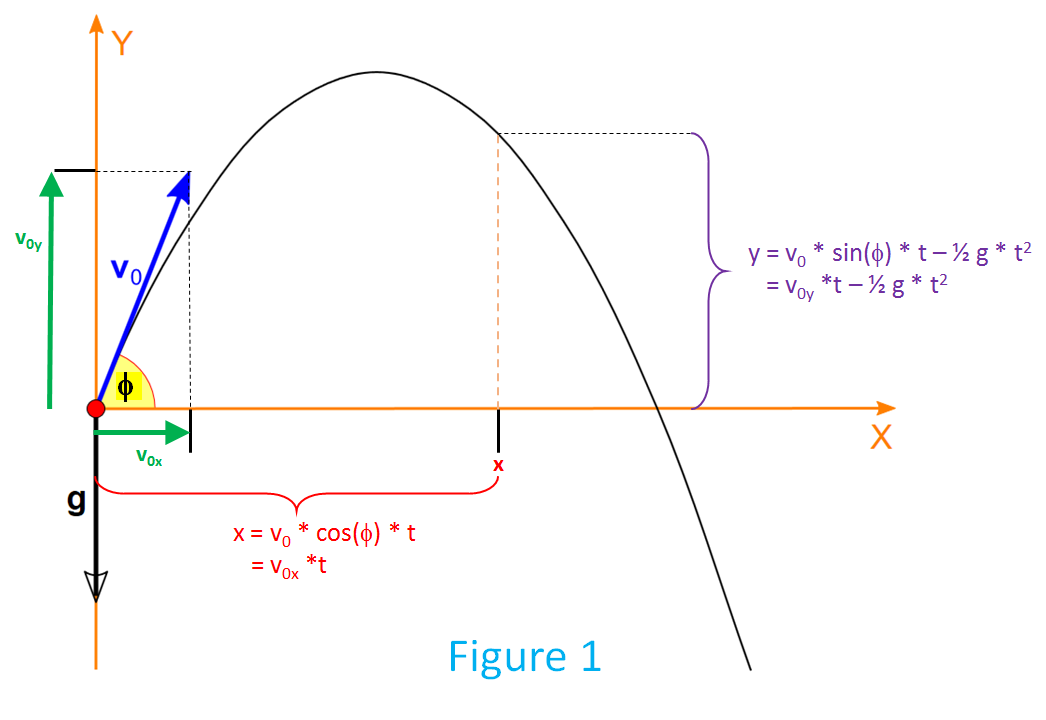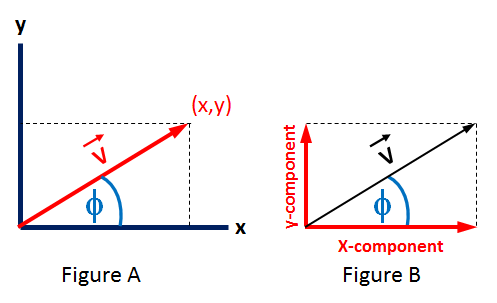Physics: Projectile Motion
Tags | |
UUID | 4269391e-8d55-11e4-a9fb-bc764e2038f2 |
The Projectile Motion calculator includes physics equations for basic modeling of projectile motion.
This calculator's equations, constants and discussion are primarily focused on the flight trajectory of an ideal projectile. More detailed modeling would have to take into account affects due to the shape and density distribution of the projectile; for longer trajectories, the curvature of the Earth, air resistance, etc.
- acceleration - the rate of change of velocity [ See the calculator button labeled "Y-acceleration of projectile" to see the Earth's gravitational acceleration ]
- ballistics - the science of mechanics that deals with the launching, flight, behavior, and effects of projectiles, especially bullets, gravity bombs, rockets, or the like1
- projectile - an object whose path of motion can be modeled using initial velocity and is affected by such physical phenomena as gravitational acceleration, air resistance, and the rotation of the planet.
- trajectory -- the ballistic path followed by a projectile
- velocity - the rate of change of the displacement of an object
Component Motion
The basic projectile motion can be decomposed for effective analysis into an x-component parallel to the local horizontal plane and a y-component, normal to that same plane. The y-component on the Earth can be thought of as parallel to the radius of the Earth. In the ideal ballistic projectile model:
- the y-component of acceleration is due solely to the acceleration due to gravity2 ; [ See the calculator button labeled "Y-acceleration of projectile"].

- the x-component of acceleration is zero3, since we are ignoring other forces such as air resistance.
X-Component
We start with the basic kinematic equation for displacement applied in the x-direction:
`v_x = v_"0x" + a_x*t` 4 and setting `a_x` to zero as just discussed, we get `v_x = v_"0x"`. 5 [ See the calculator button labeled: "X-Velocity - constant acceleration" ]
This basically tells us that, neglecting air resistance, the horizontal velocity will remain constant at the initial x-component velocity. And from this we get the displacement in the x-direction as:
`x = x_0 + v_"0x" * t` 6 [ See the calculator button labelled: "X-Displacement - Constant Velocity" ]
So, the equations of x-component motion for an ideal projectile are:
If we start at the origin where x= 0, then the equation for displacement becomes simple: `x = v_"0x"*t`
Y-Component
Next we look at the same basic kinematic equations as applied to the y-component of projectile motion:
`v_y = v_"0y" + a_y*t` 4 , which becomes `v_y = v_"0y" - g*t`10 when we substitute the fact that the acceleration near the surface of the Earth is -g.
And the displacement in the y-direction is derived analogously to the displacement in x-direction as above.
 `y = y_0 + v_"0y" * t -1/2 * g*t^2` 11 12 [ See the calculator button labelled: "Y-Displacement - Constant Acceleration" ]
`y = y_0 + v_"0y" * t -1/2 * g*t^2` 11 12 [ See the calculator button labelled: "Y-Displacement - Constant Acceleration" ]
Component Motion with Launch Angle
The projectile motion has a launch angle. Typically we represent the path of motion as passing through the coordinate system's origin at time, t = 0. At this instant the velocity vector is at the launch angle, `phi`, to the x-axis.
If the magnitude of the initial velocity is `v_0`, then the initial velocity at time, t = 0, can be represented by x and y components as:
- `v_"0x" = v_0 * cos(phi)` 13 [See the calculator button labeled "Ballistic Initial X Velocity"]
- `v_"0y" = v_0 * sin(phi)` 14 [See the calculator button labeled "Ballistic Initial Y Velocity"]
Using the equation reflected above for x and y-displacement and x and y velocity, we can substitute these two initial velocity components (`v_"0x", v_"0y"`) to get the component displacement and velocity equations:
`x = (v_0*cos(phi_0) * t` 15 [ See calculator button labeled Displacement - x(`v_0`,t,`theta`) ]
`y = v_0 * sin(phi_0) *t - 1/2g*t^2` 16 [ See calculator button labeled Displacement - y(t,`theta, v_0`) ]
`v_x = v_0*cos(phi_0)` 17 [ See calculator button labeled Ballistic X Velocity ]
`v_y = v_0 * sin(phi_0) - g*t` 18 [ See calculator button labeled Ballistic Y Velocity ]
If you know the initial velocity components, `v_x` and `v_y`, you can compute the launch angle, `alpha` 19, shown in Figure 1: `alpha = arctan(v_y/v_x)`
Projectile Trajectory
With the component definition of projectile motion we can derive the following information about the projectile and its trajectory:
The distance in the x-y plane at any time, t, is given by `r = sqrt(x^2 + y^2)` 20, which can also be expressed in three dimensions as `r = sqrt(x^2 + y^2 + z^2)` [ See calculator button labeled
Similarly, the velocity at any time, t, can be computed from the velocity components at that time: `v = sqrt(v_x^2 + v_y^2)` 21 and in three dimensions as `v = sqrt(v_x^2 + v_y^2 + v_z^2)`
We can solve the equation for x-component displacement, `x = (v_0*cos(phi_0) * t`, for t: `t = x / (v_0 * cos(phi_0))`.
This allows us to substitute for t in the equation for y-component displacement and derive the equation for y in terms of x. This then gives us the trajectory equation:
`y = v_0 * sin(phi_0) *t - 1/2*g*t^2` [ See the calculator button labeled Displacement - y(t, `theta`, `v_0`) ]
`y = v_0 * sin(phi_0) * [x / (v_0 * cos(phi_0))] - 1/2g*[x / (v_0 * cos(phi_0))]^2`
`y = tan(phi_0)*x - (g*x^2) / (2* v_0^2 * cos^2(phi_0))` 22 [ See the calculator button labeled Displacement - y(x, `theta`, `v_0`) ]
It is important to note that since `v_0, phi_0, and g` are constants this equation takes the form of `y = b*x -c*x^2`, which is recognizable as the equation for a parabola. The simplified trajectory, ignoring all forces besides gravity, will always be a parabolic curve.
Since we can decompose the position or velocity vector into its components parallel to the x-y-z axes, we can compute the distance of the projectile from the origin: `|vecr|` = r_x^2 + r_y^2 + r_z^2`. [ See calculator button labeled Projectile Distance ]
We can also compute the ballistic projectile's maximum height above the launch point altitude: `H_"max" = (v_0 * sin(theta))^2 / (2*g)` [ See calculator button labeled Ballistic Max Height ]
[Figure-1] Initial velocity of parabolic throwing
Source: Wikipedia / Fizped (modified to include motion equation)
URL: http://en.wikipedia.org/wiki/Projectile_motion#mediaviewer/File:Ferde_hajitas1.svg
See also
- Physics: Motion and Acceleration [calculator]
- Physics: Circular Motion [calculator]
- Ballistic Range - Delta Height
- Force of Drag
- ^ http://en.wikipedia.org/wiki/Ballistics
- ^ Young, Hugh and Freeman, Roger. University Physics With Modern Physics. Addison-Wesley, 2008. 12th Edition, (ISBN-13: 978-0321500625 ISBN-10: 0321500628 ) Pg 80, eq 3.14
- ^ Young, Hugh and Freeman, Roger. University Physics With Modern Physics. Addison-Wesley, 2008. 12th Edition, (ISBN-13: 978-0321500625 ISBN-10: 0321500628 ) Pg 80, eq 3.14
- ^ Young, Hugh and Freeman, Roger. University Physics With Modern Physics. Addison-Wesley, 2008. 12th Edition, (ISBN-13: 978-0321500625 ISBN-10: 0321500628 ) Pg 48, eq 2.8
- ^ Young, Hugh and Freeman, Roger. University Physics With Modern Physics. Addison-Wesley, 2008. 12th Edition, (ISBN-13: 978-0321500625 ISBN-10: 0321500628 ) Pg 80, eq 3.15
- ^ Young, Hugh and Freeman, Roger. University Physics With Modern Physics. Addison-Wesley, 2008. 12th Edition, (ISBN-13: 978-0321500625 ISBN-10: 0321500628 ) Pg 80, eq 3.16
- ^ Young, Hugh and Freeman, Roger. University Physics With Modern Physics. Addison-Wesley, 2008. 12th Edition, (ISBN-13: 978-0321500625 ISBN-10: 0321500628 ) Pg 80, eq 3.15
- ^ Young, Hugh and Freeman, Roger. University Physics With Modern Physics. Addison-Wesley, 2008. 12th Edition, (ISBN-13: 978-0321500625 ISBN-10: 0321500628 ) Pg 80, eq 3.19
- ^ Young, Hugh and Freeman, Roger. University Physics With Modern Physics. Addison-Wesley, 2008. 12th Edition, (ISBN-13: 978-0321500625 ISBN-10: 0321500628 ) Pg 80, eq 3.14
- ^ Young, Hugh and Freeman, Roger. University Physics With Modern Physics. Addison-Wesley, 2008. 12th Edition, (ISBN-13: 978-0321500625 ISBN-10: 0321500628 ) Pg 80, eq 3.17
- ^ Young, Hugh and Freeman, Roger. University Physics With Modern Physics. Addison-Wesley, 2008. 12th Edition, (ISBN-13: 978-0321500625 ISBN-10: 0321500628 ) Pg 49, eq 2.12
- ^ Young, Hugh and Freeman, Roger. University Physics With Modern Physics. Addison-Wesley, 2008. 12th Edition, (ISBN-13: 978-0321500625 ISBN-10: 0321500628 ) Pg 80, eq 3.18
- ^ Young, Hugh and Freeman, Roger. University Physics With Modern Physics. Addison-Wesley, 2008. 12th Edition, (ISBN-13: 978-0321500625 ISBN-10: 0321500628 ) Pg 81, eq 3.19
- ^ Young, Hugh and Freeman, Roger. University Physics With Modern Physics. Addison-Wesley, 2008. 12th Edition, (ISBN-13: 978-0321500625 ISBN-10: 0321500628 ) Pg 81, eq 3.19
- ^ Young, Hugh and Freeman, Roger. University Physics With Modern Physics. Addison-Wesley, 2008. 12th Edition, (ISBN-13: 978-0321500625 ISBN-10: 0321500628 ) Pg 81, eq 3.20
- ^ Young, Hugh and Freeman, Roger. University Physics With Modern Physics. Addison-Wesley, 2008. 12th Edition, (ISBN-13: 978-0321500625 ISBN-10: 0321500628 ) Pg 81, eq 3.21
- ^ Young, Hugh and Freeman, Roger. University Physics With Modern Physics. Addison-Wesley, 2008. 12th Edition, (ISBN-13: 978-0321500625 ISBN-10: 0321500628 ) Pg 81, eq 3.22
- ^ Young, Hugh and Freeman, Roger. University Physics With Modern Physics. Addison-Wesley, 2008. 12th Edition, (ISBN-13: 978-0321500625 ISBN-10: 0321500628 ) Pg 81, eq 3.23
- ^ Young, Hugh and Freeman, Roger. University Physics With Modern Physics. Addison-Wesley, 2008. 12th Edition, (ISBN-13: 978-0321500625 ISBN-10: 0321500628 ) Pg 81, eq 3.26
- ^ Young, Hugh and Freeman, Roger. University Physics With Modern Physics. Addison-Wesley, 2008. 12th Edition, (ISBN-13: 978-0321500625 ISBN-10: 0321500628 ) Pg 81, eq 3.24
- ^ Young, Hugh and Freeman, Roger. University Physics With Modern Physics. Addison-Wesley, 2008. 12th Edition, (ISBN-13: 978-0321500625 ISBN-10: 0321500628 ) Pg 81, eq 3.25
- ^ Young, Hugh and Freeman, Roger. University Physics With Modern Physics. Addison-Wesley, 2008. 12th Edition, (ISBN-13: 978-0321500625 ISBN-10: 0321500628 ) Pg 81, eq 3.27
Equations and Data Items
Collections
- Comments
- Attachments
- Stats
No comments |
